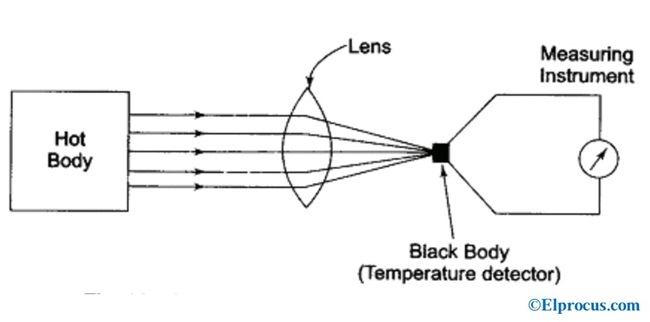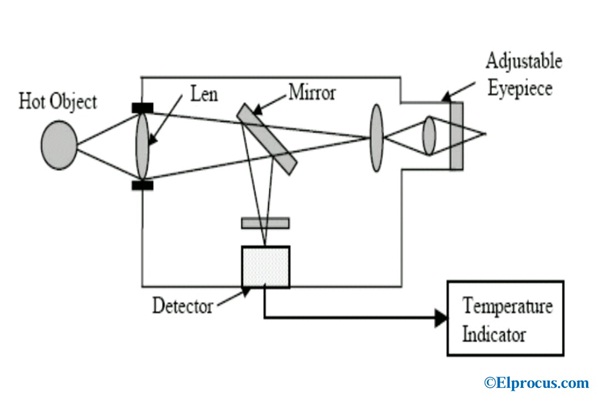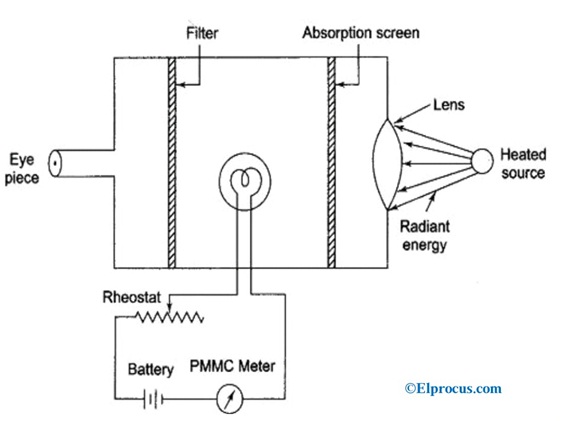What is Pyrometer?
Pyrometer also is known as an Infrared thermometer or Radiation thermometer or non-contact thermometer used to detect the temperature of an object’s surface temperature, which depends on the radiation (infrared or visible) emitted from the object. Pyrometers act as photodetector because of the property of absorbing energy and measuring of EM wave intensity at any wavelength.
These are used to measure high-temperature furnaces. These devices can measure the temperature very accurately, precisely, pure visually and quickly. Pyrometers are available in different spectral ranges ( since metals – short wave ranges and non-metals-long wave ranges).

Color pyrometers are used to measure the radiation emitted from the object during the temperature measurement. These can measure the object’s temperature very accurately. Hence the measuring errors are very low with these devices.
Color pyrometers are used to determine the ratio of two radiation intensities with two spectral ranges. These are available in series of Metis M3 and H3 and handheld portables Capella C3 in different versions.
High-speed pyrometers are used to temperature more fastly and quickly than M3 devices. These are available in combination with 1-color and 2-color pyrometers. These devices can create clear temperature profiles of fast-moving objects and control the adequate temperature level.
Working Principle of Pyrometer
Pyrometers are the temperature measuring devices used to detect the object’s temperature and electromagnetic radiation emitted from the object. These are available in different spectral ranges. Based on the spectral range, pyrometers are classified into 1-color pyrometers, 2-color pyrometers, and high-speed pyrometers.
The basic principle of the pyrometer is, it measures the object’s temperature by sensing the heat/radiation emitted from the object without making contact with the object. It records the temperature level depending upon the intensity of radiation emitted. The pyrometer has two basic components like optical system and detectors that are used to measure the surface temperature of the object.
When any object is taken whose surface temperature is to be measured with the pyrometer, the optical system will capture the energy emitted from the object. Then the radiation is sent to the detector, which is very sensitive to the waves of radiation. The output of the detector refers to the temperature level of the object due to the radiation. Note that, the temperature of the detector analyzed by using the level of radiation is directly proportional to the object’s temperature.
The radiation emitted from every targeted object with its actual temperature goes beyond the absolute temperature ( -273.15 degrees Centigrade ). This emitted radiation is referred to as Infrared, which is above the visible red light in the electromagnetic spectrum. The radiated energy is used for detecting the temperature of the object and it is converted into electrical signals with the help of a detector.
Types of Pyrometer
To detect the different object’s temperature, pyrometers are classified into 2 types. They are,
- Optical Pyrometers
- Infrared / Radiation pyrometers
Optical Pyrometers
These are one of the types of pyrometers used to detect thermal radiation of the visible spectrum. The temperature of the hot objects measured will depend on the visible light they emit. Optical pyrometers are capable of providing a visual comparison between a calibrated light source and the targeted object’s surface. When the temperature of the filament and the object’s surface is the same, then the thermal radiation intensity caused due to the filament merges and into the targeted object’s surface and becomes invisible. When this process happens, the current passing through the filament is converted into a temperature level.

Infrared or Radiation Pyrometers
These pyrometers are designed to detect thermal radiation in the infrared region, which is usually at a distance of 2-14um. It measures the temperature of a targeted object from the emitted radiation. This radiation can be directed to a thermocouple to convert into electrical signals. Because the thermocouple is capable of generating higher current equal to the heat emitted. Infrared pyrometers are made up of pyroelectric materials like polyvinylidene fluoride (PVDF), triglycine sulfate (TGS), and lithium tantalate (LiTaO3).

Advantages/Disadvantages
Usually, Pyrometers are compared with thermometers and also have some advantages and disadvantages while using.
The advantages of pyrometer are
- It can measure the temperature of the object without any contact with the object. This is called Non-contact measurement.
- It has a fast response time
- Good stability while measuring the temperature of the object.
- It can measure different types of object’s temperature at variable distances.
The disadvantages of pyrometer are
- Pyrometers are generally rugged and expensive
- Accuracy of the device can be affected due to the different conditions like dust, smoke, and thermal radiation.
Applications
Pyrometers are used in different applications such as,
- To measure the temperature of moving objects or constant objects from a greater distance.
- In metallurgy industries
- In smelting industries
- Hot air balloons to measure the heat at the top of the ballon
- Steam boilers to measure steam temperature
- To measure the temperature of liquid metals and highly heated materials.
- To measure furnace temperature.
Comments
Post a Comment